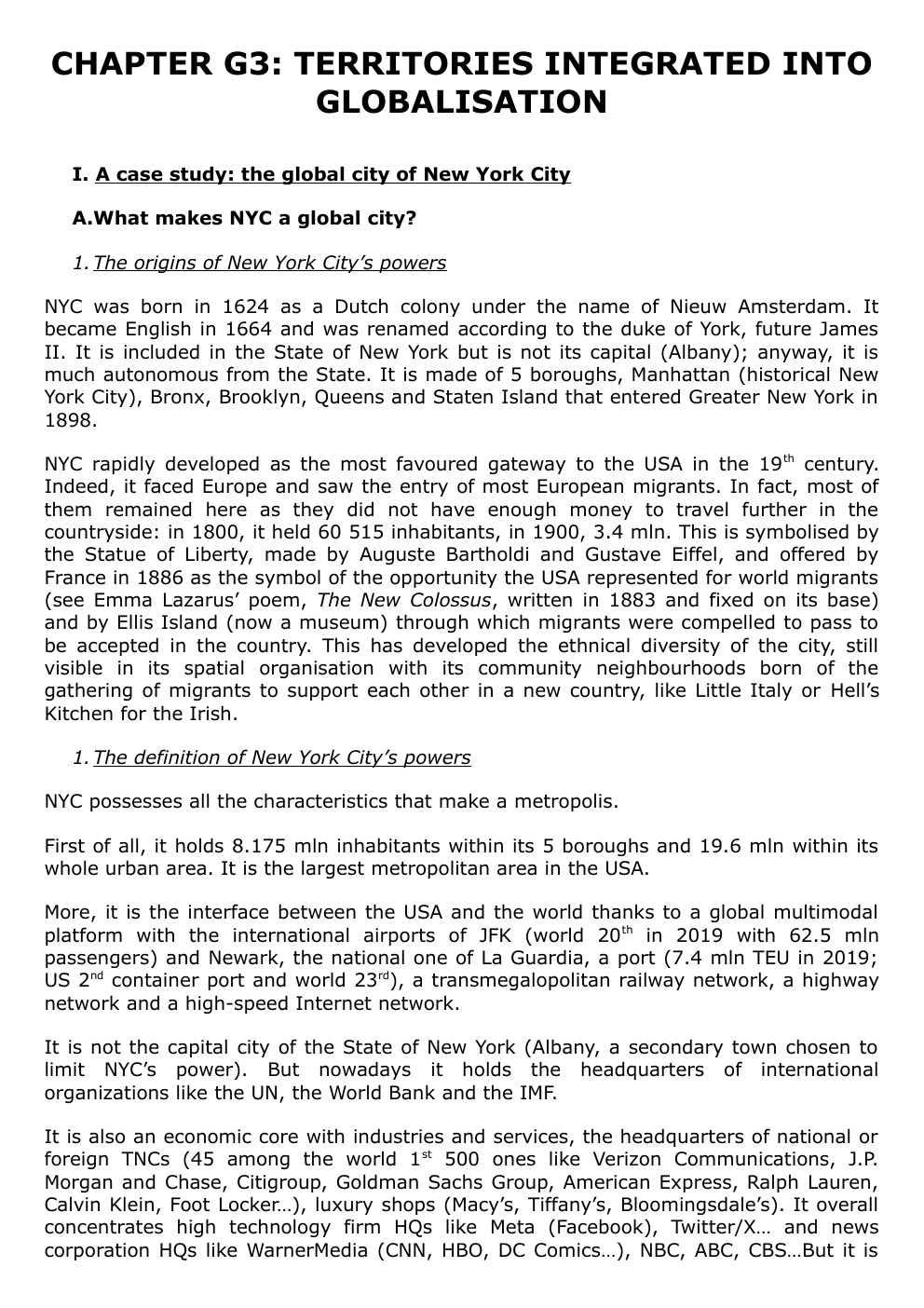CHAPTER G3: TERRITORIES INTEGRATED INTO GLOBALISATION
Publié le 06/05/2024
Extrait du document
«
CHAPTER G3: TERRITORIES INTEGRATED INTO
GLOBALISATION
I.
A case study: the global city of New York City
A.What makes NYC a global city?
1.
The origins of New York City’s powers
NYC was born in 1624 as a Dutch colony under the name of Nieuw Amsterdam.
It
became English in 1664 and was renamed according to the duke of York, future James
II.
It is included in the State of New York but is not its capital (Albany); anyway, it is
much autonomous from the State.
It is made of 5 boroughs, Manhattan (historical New
York City), Bronx, Brooklyn, Queens and Staten Island that entered Greater New York in
1898.
NYC rapidly developed as the most favoured gateway to the USA in the 19 th century.
Indeed, it faced Europe and saw the entry of most European migrants.
In fact, most of
them remained here as they did not have enough money to travel further in the
countryside: in 1800, it held 60 515 inhabitants, in 1900, 3.4 mln.
This is symbolised by
the Statue of Liberty, made by Auguste Bartholdi and Gustave Eiffel, and offered by
France in 1886 as the symbol of the opportunity the USA represented for world migrants
(see Emma Lazarus’ poem, The New Colossus, written in 1883 and fixed on its base)
and by Ellis Island (now a museum) through which migrants were compelled to pass to
be accepted in the country.
This has developed the ethnical diversity of the city, still
visible in its spatial organisation with its community neighbourhoods born of the
gathering of migrants to support each other in a new country, like Little Italy or Hell’s
Kitchen for the Irish.
1.
The definition of New York City’s powers
NYC possesses all the characteristics that make a metropolis.
First of all, it holds 8.175 mln inhabitants within its 5 boroughs and 19.6 mln within its
whole urban area.
It is the largest metropolitan area in the USA.
More, it is the interface between the USA and the world thanks to a global multimodal
platform with the international airports of JFK (world 20 th in 2019 with 62.5 mln
passengers) and Newark, the national one of La Guardia, a port (7.4 mln TEU in 2019;
US 2nd container port and world 23rd), a transmegalopolitan railway network, a highway
network and a high-speed Internet network.
It is not the capital city of the State of New York (Albany, a secondary town chosen to
limit NYC’s power).
But nowadays it holds the headquarters of international
organizations like the UN, the World Bank and the IMF.
It is also an economic core with industries and services, the headquarters of national or
foreign TNCs (45 among the world 1 st 500 ones like Verizon Communications, J.P.
Morgan and Chase, Citigroup, Goldman Sachs Group, American Express, Ralph Lauren,
Calvin Klein, Foot Locker…), luxury shops (Macy’s, Tiffany’s, Bloomingsdale’s).
It overall
concentrates high technology firm HQs like Meta (Facebook), Twitter/X… and news
corporation HQs like WarnerMedia (CNN, HBO, DC Comics…), NBC, ABC, CBS…But it is
also a financial core with the NYSE and the NASDAQ (the world 1 st 2 stock exchanges),
many banks and financial services (Wall Street).
This power is marked in the skyline
made of numerous skyscrapers, some of which are famous in the whole world: Empire
State Building (381m, 1930), Chrysler Building (319m, 1928), Rockefeller Center (set of
19 buildings among which the Comcast Building, 266m 1931-1933, NBC HQ).
It is a cosmopolitan space too, inherited from its role of the gateway of the USA: 1/3 of
its population is immigrant, ½ of its workforce; ½ of it speaks another language than
English at home.
It is symbolised by Chinatown or Little Italy… This is a “mini-world”.
But this “openness” is not without tensions between the different communities.
Besides,
there are also a lot of American people coming from any parts of the country, and
overall from the more rural parts, for whom NYC means opportunities.
At last, it has a world cultural influence: it keeps a lot of monuments from its past
(Statue of Liberty, Ellis Island, Empire State building, Brooklyn Bridge), prestigious
museums (the Metropolitan Museum of Art, the Museum of Modern Art/MoMA and the
Guggenheim Museum), the recent Memorial of the 9/11 (Ground Zero), beautiful spaces
(Washington Square, Central Park), 88 universities (NY University, Columbia) and
entertainment places (Time Square, Broadway with its musicals).
NYC is also the core of
the US high culture (the Metropolitan Opera) and of a restless cultural life (fashion
week, music/NYADA, New York Academy of Dramatic Arts).
There are international
sports events like the US Open Tennis Championships (Flushing Meadows), performed in
great stadiums (Madison Square Gardens), and with famous teams (the Yankees or the
Mets in baseball).
That’s why tourism is very important for the city, 66.6mln in 2019.
A.The spatial organisation of the metropolis of NYC
NYC is behind the typical....
»
↓↓↓ APERÇU DU DOCUMENT ↓↓↓
Liens utiles
- Corée du Sud - 1994-1995: À l'ère de la globalisation
- La globalisation financière
- Tom Jones (1749)Henry FieldingBook I -- Chapter 1An author ought to consider himself, not as a gentleman who gives a private oreleemosynary treat, but rather as one who keeps a public ordinary, at which allpersons are welcome for their money.
- With the fall of communism the collapse of trade with the former USSRplunged this country into serious economic difficulties.
- La globalisation financière a profondément modifié le fonctionnement de l'économie mondiale


